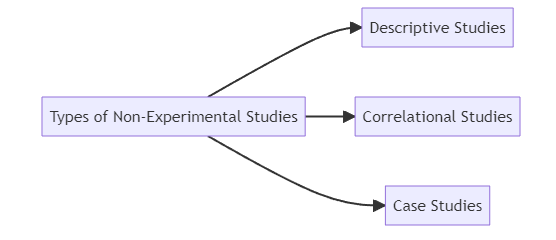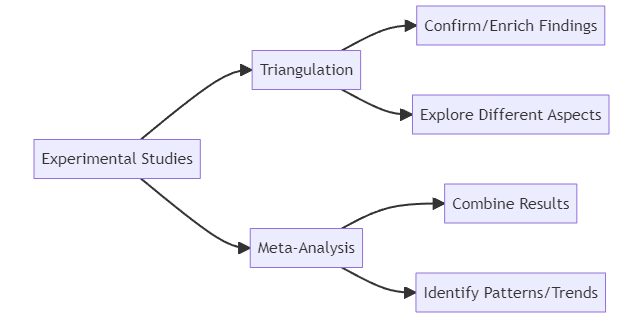Non-experimental studies are a vital and often overlooked part of research. In this article, we’ll explain the definition, types and characteristics of non-experimental studies as well as their advantages and disadvantages. Following this, we’ll go over some examples of non-experimental research across a range of different fields and provide some tips for undertaking these studies. Finally, we’ll explain how non-experimental studies can be combined with experimental studies to help strengthen your research.
Non-experimental studies are different from experimental studies in that they don’t involve manipulating variables. They don’t have a control group either. Instead, they rely on observation and analysis of existing data or natural events in an attempt to gain valuable insights into our understanding of the world.
Whether you’re a research student in psychology, sociology, education, or any other field, this article will give you a comprehensive overview of non-experimental studies and their role in research. So if you want to learn more about these critical research methods, keep reading!
Definition of Non-Experimental Studies
As mentioned before, non-experimental studies, also known as observational studies, are research methods that are used to observe and describe a phenomenon without manipulating a single variable. In other words, non-experimental studies don’t involve the controlled manipulation of an independent variable in order to see what effect it has on a dependent variable. On the contrary, non-experimental research relies on naturally occurring or existing data and do not involve any interventions from those undertaking the research.
Differences Between Experimental and Non-Experimental Studies
There are several critical differences between experimental and non-experimental studies that you ought to be aware of:
- Control: In experimental studies, the researcher has complete control over the independent variable and can manipulate it to study its effects on the dependent variable. In non-experimental research, the researcher doesn’t have control over the variables; they can only observe and describe them.
- Intervention: Experimental studies involve manipulating variables through some form of intervention, whether it be administering a treatment or altering a condition. Non-experimental studies, on the other hand, don’t involve any intervention. They simply describe the variables as they exist in their natural state.
- Cause and effect: Experimental studies are designed to establish cause and effect relationships between variables. Non-experimental studies cannot establish cause and effect because they don’t involve changing variables, so it would be impossible to pinpoint certain effects onto any one thing.
- Randomization: Experimental studies typically involve using randomization to assign subjects to treatment or control groups. Non-experimental research do not involve randomization.
- Sample size: Experimental studies typically involve smaller sample sizes because they are more controlled and require fewer subjects to establish statistical significance. Non-experimental studies often involve larger sample sizes because they do not involve the manipulation of variables and therefore require more subjects to observe and describe the phenomenon.
In short, non-experimental studies help describe and understand phenomena but are not as helpful in establishing cause and effect relationships. However, non-experimental studies can be combined with experimental studies to provide a more comprehensive understanding of a phenomenon.
Types of Non-Experimental Studies
Researchers can use several types of non-experimental studies to investigate a research question or phenomenon. These include descriptive studies, correlational studies, and case studies.

1. Descriptive Studies
Descriptive studies are used to describe the characteristics of a group or population. These studies are often used to identify patterns or trends in a particular phenomenon. Researchers typically use survey methods or observational techniques to gather data in descriptive studies.
Examples of descriptive studies include surveys, observational studies, and demographic studies.
2. Correlational Studies
Correlational studies investigate the relationship between two or more variables. These studies do not seek to manipulate variables or determine cause and effect but rather explore whether there is a correlation between the variables being studied.
Researchers typically use statistical techniques to analyze data collected in correlational studies.
Examples of correlational studies include studies that investigate the causal relationship between exercise and mental health or the statistical relationship between social media use and academic performance.
3. Case Studies
Case studies involve an in-depth examination of a single individual, group, or event. These studies are often used to explore complex phenomena or to provide insight into a specific situation or context. Researchers typically use various methods to collect data in case studies, including interviews, observations, and document analysis.
Examples of case studies include studies that investigate the experiences of a single individual with a particular medical condition or the cultural dynamics of a small community.
Non-experimental studies provide valuable information and offer unique insights into a research question or phenomenon. While they have their limitations, they can be an essential part of the research process and can be used in combination with experimental studies to provide a more complete understanding of a topic.
Advantages of Non-Experimental Studies
Non-experimental studies have several advantages that make them useful for certain types of research. Some of the main benefits of non-experimental studies include:
- Greater flexibility: Non-experimental studies are often more flexible than experimental studies, as they do not require the researcher to manipulate variables or control for extraneous factors. This means that researchers can more easily adapt their methods to changing circumstances or unexpected results.
- Greater realism: Non-experimental studies often provide a more realistic and naturalistic portrayal of the research setting, as they do not involve the artificial manipulation of extraneous variables. This can make the results of non-experimental studies more generalizable to real-world situations.
- Greater cost-effectiveness: Non-experimental studies are generally less expensive than experimental studies, as they do not require specialized equipment or procedures. This makes non-experimental studies a more cost-effective option for researchers on a budget.
Disadvantages of Non-Experimental Studies
Despite their advantages, non-experimental research also has several limitations that should be considered when deciding whether to use this type of study in research. Some of these include:
- Lack of control over variables: One of the main limitations of non-experimental studies is the lack of control over variables. Researchers cannot manipulate variables or control for extraneous factors, so it is more difficult to establish cause and effect relationships.
- Limited generalizability: They often have limited generalizability, as they are conducted in a specific context or population. This means that the results of non-experimental studies may not be applicable to other populations or settings.
- Difficulty measuring change: Non-experimental studies are typically conducted at a single point in time, which makes it difficult to measure change over time. This can be a problem if the research question examines changes in behaviour or attitudes over time.
- Potential bias: Non-experimental studies are prone to bias, as the researcher cannot control all factors that may affect the results. This means that the results of non-experimental studies may be influenced by factors not accounted for in the study design.
Examples of Non-Experimental Studies in Different Fields
Psychology
- Case studies: These are in-depth studies of a single individual or small group, often used to explore rare or unusual phenomena. For example, a case study of a person with a rare neurological disorder can provide insight into the symptoms and treatment options for that disorder.
- Surveys: Surveys involve collecting data from a large number of people using self-report measures such as questionnaires or interviews. Surveys can be used to study various topics, from attitudes and beliefs to behaviours and experiences. For example, a survey of college students’ attitudes towards mental health treatment could provide valuable information for addressing the needs of this population.
- Observational studies: Observational studies involve watching and recording the behaviour of people or animals in a natural setting. These studies can help understand social interactions and other complex behaviours. For example, an observational study of parenting styles in different cultures could provide insight into how parenting practices affect child development.
Sociology
- Ethnographies: Ethnographies involve detailed observations and interviews with members of a particular culture or community. They are often used to understand social norms, values, and beliefs in a specific group. For example, an ethnography of a rural community might examine how traditional gender roles are maintained and how they affect the lives of men and women in that community.
- Content analysis: This involves systematically analyzing written or spoken texts (such as books, newspapers, or social media posts) to understand patterns or themes within a particular culture or society. For example, a content analysis of news articles about immigration might reveal underlying biases or stereotypes about immigrants.
- Longitudinal studies: These are studies that follow the same group of people over an extended period of time. They can be used to understand how social or environmental factors affect people’s lives over time. For example, a longitudinal study of first-generation college students might examine how family and community support, financial stress, and other factors impact their academic success.
Education
- Action research: This involves researchers actively collaborating with teachers and students in a particular educational setting to identify problems and develop solutions. Action research can be useful for understanding and improving teaching and learning practices. For example, an action research project might involve a teacher working with researchers to design and implement a new teaching method and then evaluating the results to see if it was successful.
- Narrative inquiry: This involves collecting and analyzing stories or narratives from individuals or groups to understand their experiences and perspectives. Narrative inquiry is often used in education to understand how students learn and how teachers teach. For example, a narrative inquiry study of high school students’ experiences with bullying might help educators understand the impact of bullying on academic performance and mental health.
- Ethnographic case studies: These are in-depth studies of a particular school or classroom that use observations, interviews, and other data collection methods to understand the social and cultural factors that shape the educational experience. Ethnographic case studies can provide valuable insights into how education policies and practices affect students and teachers. For example, an ethnographic case study of a bilingual classroom might explore how language acquisition and cultural differences impact students’ learning.
How to Conduct Non-Experimental Studies: Tips and Best Practices
Conducting a non-experimental study can be a challenging task for research students. However, with proper planning and execution, it is possible to produce high-quality research using this method. Here are some tips and best practices for conducting a non-experimental study:
1. Planning and Designing the Study
- Identify the research question and objectives: Clearly define your study’s research question and objectives. This will help you focus on the specific aspects of the research that you want to explore.
- Determine the study sample size and sampling method: Consider the size and characteristics of the sample you need to answer your research question accurately. Choose a sampling method that is appropriate for your study and ensures that the sample is representative of the population. This will help make sure your findings will be backed by strong evidence.
- Consider the limitations of the study: Be aware of the limitations of your study, including any biases or confounding variables that may affect the results. Consider how you can address these limitations in your original study design.
- Develop a research plan: Create a detailed research plan outlining the steps you will take to conduct the study. This will help you stay organized and on track throughout the research process.
2. Data Collection and Analysis
- Choose appropriate data collection methods: Select data collection methods appropriate for your research question and study design. This could include surveys, interviews, observations, or existing data sources.
- Ensure the validity and reliability of data collection methods: Ensure that the data collection methods you use are valid and reliable. Validity refers to whether the data accurately measures what it is intended to measure. Reliability refers to the consistency of the results.
- Use appropriate data analysis techniques: Choose data analysis techniques appropriate for the type of data you have collected and the research question you are trying to answer. This could include descriptive statistics, correlation analysis, or regression analysis.
3. Interpreting and Reporting Results
- Interpret the results accurately: Carefully interpret the results of your study, keeping in mind the study’s limitations and possible biases or confounding variables.
- Report the results clearly and concisely: Present the results of your study clearly and concisely, using appropriate graphs, tables, and statistical analyses to illustrate the findings.
- Conclusion: Summarize the main findings and implications of the study: In the conclusion, summarize the study’s main findings and discuss their implications for the research field. Consider how the results of the study contribute to the existing body of knowledge and identify any areas for future research.
How to Use Non-Experimental Studies in Combination with Experimental Studies
There are two main ways to combine non-experimental studies with experimental studies: triangulation and meta-analysis.

Triangulation
Triangulation is the use of multiple methods, data sources, or perspectives in a study to increase the validity of the results. This can include combining experimental and non-experimental studies.
For example, a researcher may conduct an experimental study to test a specific hypothesis and then follow it up with a non-experimental study using a different method, such as a survey or case study, to provide additional support for the results.
Using triangulation allows researchers to confirm or enrich the findings from one method with the findings from another method. It also allows researchers to explore different aspects of a research question and address a single method’s potential limitations.
Meta-Analysis
Meta-analysis is a statistical method that combines the results from multiple studies to provide a more precise estimate of the effect size. This is particularly useful when the analysed studies have different designs, such as experimental and non-experimental studies.
Meta-analysis allows researchers to combine the results from multiple studies and to identify patterns and trends that may not be apparent in individual studies. It also allows researchers to account for differences in study design, sample size, and other factors that may affect the results.
However, it’s important to note that meta-analysis is only appropriate when the studies being analyzed are sufficiently similar and when the data can be combined in a meaningful way.
Conclusion: The Role of Non-Experimental Studies in Research
Non-experimental studies are an essential and valuable tool in research. They allow researchers to explore complex phenomena and relationships in natural settings, examine individual cases in depth, and study a variety of contexts and perspectives.
While non-experimental studies may not have the same level of control as experimental studies, they can provide valuable insights and can be used in combination with experimental studies to increase the validity and generalizability of research findings.
In conclusion, non-experimental studies have a valuable role in research and should be considered a viable option for addressing research questions.








